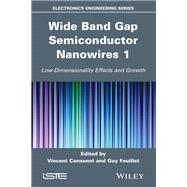GaN and ZnO nanowires can by grown using a wide variety of methods from physical vapor deposition to wet chemistry for optical devices. This book starts by presenting the similarities and differences between GaN and ZnO materials, as well as the assets and current limitations of nanowires for their use in optical devices, including feasibility and perspectives. It then focuses on the nucleation and growth mechanisms
of ZnO and GaN nanowires, grown by various chemical and physical methods. Finally, it describes the formation of nanowire heterostructures applied to optical devices.









